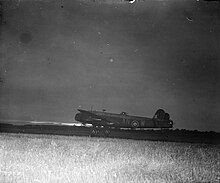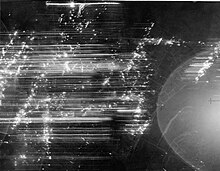Air raids on Düsseldorf


The city was badly destroyed in the air raids on Düsseldorf during the Second World War. It suffered the heaviest attack on June 12, 1943, when a firestorm was kindled by targeted bombardment by the British Royal Air Force , which largely destroyed the historic city center, the city center and other neighboring districts.
prehistory
As the “ desk of the Ruhr area ”, the city has been the focus of British air strikes since the beginning of the war. The first British air raid on the districts of Flingern and Oberbilk on May 14, 1940 , which mainly hit Hermannplatz and Dorotheenstrasse and resulted in seven injuries and one fatality, caused only minor damage. On December 7, 1940 around 700 stick bombs and around 50 high-explosive bombs fell on the city center, Pempelfort, Flingern, Oberbilk and Benrath. Numerous other minor attacks followed. On the night of August 1, 1942, the people of Düsseldorf experienced the first major attack. This first major attack initiated a series of attacks that ended with the destruction of more than half of Düsseldorf's buildings. In another major attack on September 11, 1942, the town hall was severely damaged.
The total of well over 243 attacks cost the lives of over 6,000 civilians.
The first major attack on the night of August 1, 1942
In the 113th air raid on Düsseldorf on August 1, 1942, the first major attack, a British unit dropped almost 14,000 stick bombs, mainly over the city center, Oberkassel and the southern parts of the city. The Königsallee was hit for the first time, and considerable damage was caused, especially in the area of Oststrasse and Friedrich-Ebert-Strasse.
Düsseldorf had around 250 victims to mourn, the neighboring city of Neuss 34. Around 12,000 people were left homeless as a result of the attack. 314 residential buildings were completely destroyed after the attack, 654 badly damaged, 1,628 medium and 9,030 light. There were also various public buildings, industrial plants and Wehrmacht facilities.
Flak and night fighters brought down some of the 630 bombers involved that night. A Wellington bomber crashed near Düsseldorf-Knittkuhl.
Attack on June 12, 1943
The exact selection of the districts to be bombed was made on the basis of aerial photographs, population density maps and fire insurance cadastre maps. The cadastral maps had been deposited by German fire insurance companies with British reinsurance companies before the war. The old town of Düsseldorf was chosen as the core area of the attack, there was here the wood proportion of the total building volume is highest. This made it the ideal core target area for igniting a firestorm in Düsseldorf.
Before the bombing, the target area for mosquito high-speed bombers was demarcated by red and green markings (so-called Christmas trees). This was monitored by a master bomber flying at high altitude, which was connected to the marker pilots via radio. The attack began at 1:15 a.m. with the setting of the marker bodies.
The bombing

The target area of the attack on Düsseldorf was essentially the densely populated city center - especially the old town. The bombardment began at 1:25 am. The entire attack lasted an hour and 20 minutes. First, 1,300 explosive bombs and several hundred air mines were dropped. The roofs were torn open by the pressure waves of the explosions. Then more than 225,000 electron-thermite stick incendiary bombs were dropped over the city area, which fell into the torn roof trusses of the houses and set them on fire within a very short time. Within an hour, thousands of smaller building fires spread into a firestorm. In the attacked districts of Derendorf , Düsseldorf-Zentrum and in Düsseldorf's Südstadt district, a 40 square kilometer sea of fire with a total of around 9,000 individual fires developed.
Damage and sacrifice
Around 600 people were killed and more than 3,000 people wounded in this major attack . 16 churches, 13 hospitals, 28 schools and several thousand residential buildings were destroyed or severely damaged. Large parts of the city center, Derendorf, Carlstadt, Friedrichstadt, Unterbilk, Bilk, Oberbilk and the Südstadt were completely destroyed. Extensive damage occurred in the entire area between Reeser Platz in the north and the hospital in the south.
More attacks and damage

Another major attack on the night of November 3rd to 4th, 1943 claimed 622 lives. Even greater damage occurred on the night of April 22-23, 1944, when 1,200 people were killed and 20,500 were left homeless. Another major attack on the night of November 2nd to 3rd, 1944 resulted in 748 deaths and 15,000 homeless people.
Further attacks followed later, which left a huge devastation in Düsseldorf with a total of 1.14 million incendiary bombs by the end of the war . In the area of the core city, 93% of all residential buildings, 96% of the public and 93% of the commercial buildings were destroyed or damaged. Of the 535,000 residents at the start of the war, a large number had fled the city. At the end of the war, fewer than 250,000 were living in the ruins of Düsseldorf. 10,000,000 cubic meters of rubble had to be removed.
reception
British Prime Minister Winston Churchill explicitly mentioned the air raid of June 12, 1943 in a speech he gave on June 30, 1943 on the occasion of the award of the honorary citizenship of London. This attack, Churchill said, would have demonstrated the superiority of the British Air Force. In Düsseldorf, the air raid of June 12th, which took place on the Saturday before Pentecost 1943, went down in history as the “Pentecostal attack ”.
See also
- Air raids on the Ruhr area (this also takes account of the events in Düsseldorf)
- Air War in World War II
- List of Allied air raids on the German Reich (1939–1945)
literature
- City Archives Düsseldorf, IV 483, Garden and Cemetery Office, September 25, 1944; IV 481, main office, March 15, 1944 and brochure.
- Alfons Houben: Düsseldorf. Hour zero. 1945/46 - end and beginning , Düsseldorf 1985.
- Peter Hüttenberger: The industrial and administrative city (20th century) , In: Düsseldorf. History from the origins to the 20th century , Vol. 3, Düsseldorf 1989.
- Documentation on the history of the city of Düsseldorf. In the “Third Reich” 1935–1945 , source collection, ed. v. Pedagogical Institute of the State Capital Düsseldorf, Düsseldorf 1983.
- Friedrich-Wilhelm Henning: Düsseldorf and its economy. About the history of a region. Vol. 2: From 1860 to the present , Düsseldorf 1981.
- Clemens von Looz-Corswarem: The city in ruins - Düsseldorf in the Second World War . In: The Düsseldorf Atlas. The past and present of the state capital in a map , Cologne 2004, p. 48 f.
- Clemens von Looz-Corswarem: The account book of the city of Düsseldorf from the years 1540/41. A contribution to the history of the city in the middle of the 16th century . In: Düsseldorfer Jahrbuch 72 (2001), pp. 13–95.
- Anna Schack: The house No. 131 , Flensburg / Hamburg 1946, new edition Berlin 2013 PDF
- Gaby and Peter Schulenberg: A bunker for Jan Wellem . In: Archäologie im Rheinland 2002, Stuttgart 2003, pp. 221–223.
- Olaf Steinacker: Bomb war over Düsseldorf , Gudensberg-Gleichen 2003.
- Hugo Weidenhaupt: Brief history of the city of Düsseldorf , Düsseldorf 1983 (9).
- Volker Zimmermann: In rubble and ashes. The end of the Second World War in Düsseldorf , Düsseldorf 1995.
- Marcel Lesaar: Air raid on Düsseldorf and Neuss . Books on Demand, Norderstedt, ISBN 978-3-7460-9779-4 .
Web links
- 70 years ago, Düsseldorf was reduced to rubble , article dated June 18, 2013 in the derwesten.de portal
- Düsseldorf in the bombing war , website with references in the portal duesseldorf.de
Individual evidence
- ^ A b Friedrich-Wilhelm Henning: Düsseldorf and its economy. About the history of a region. Vol. 2: From 1860 to the present. Düsseldorf 1981, p. 84 f.
- ^ Benedikt Mauer: Düsseldorf in the bombing war , website in the portal langzeitarchivierung.bib-bvb.de
- ^ Marcel Lesaar: Air raid on Düsseldorf and Neuss. Books on Demand, Norderstedt, ISBN 978-3-7460-9779-4 .
- ^ A b c Friedrich-Wilhelm Henning: Düsseldorf and its economy. About the history of a region. Vol. 2: From 1860 to the present. Pp. 93-117 f.
- ↑ AC Grayling: The Dead Cities: Were Allied Bombing War Crimes? Munich 2009, p. 369.
- ↑ AC Grayling: The Dead Cities: Were Allied Bombing War Crimes? P. 374.
- ↑ AC Grayling: The Dead Cities: Were Allied Bombing War Crimes? P. 380.
- ↑ Florian Schmitz: Whitsun attack: bombers put Düsseldorf in rubble and ashes. In: Westdeutsche Zeitung . June 10, 2013 ( wz.de ).
- ↑ Düsseldorf in the bombing war , website in the portal duesseldorf, de , accessed on January 15, 2016.



